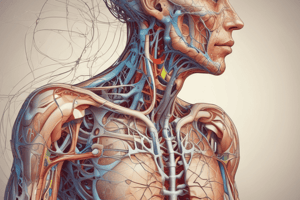Podcast
Questions and Answers
What is a key function of the nervous system in maintaining internal balance?
What is a key function of the nervous system in maintaining internal balance?
- Detecting changes in external stimuli
- Controlling heart rate
- Overseeing feedback mechanisms (correct)
- Producing insulin for blood glucose regulation
Which part of the body is responsible for detecting changes and initiating corrective actions in negative feedback loops?
Which part of the body is responsible for detecting changes and initiating corrective actions in negative feedback loops?
- Pancreas
- Liver
- Skeletal muscles
- Hypothalamus (correct)
In negative feedback loops, what happens when blood glucose levels rise above normal?
In negative feedback loops, what happens when blood glucose levels rise above normal?
- Release of adrenaline
- Increased insulin secretion (correct)
- Activation of the parasympathetic nervous system
- Dilation of blood vessels
Which component of the nervous system is involved in increasing heart rate and constricting blood vessels when blood pressure rises?
Which component of the nervous system is involved in increasing heart rate and constricting blood vessels when blood pressure rises?
What is the primary goal of negative feedback mechanisms in the human body?
What is the primary goal of negative feedback mechanisms in the human body?
What is the main function of the sympathetic branch of the autonomic nervous system?
What is the main function of the sympathetic branch of the autonomic nervous system?
Which system restores calmness by slowing down bodily processes?
Which system restores calmness by slowing down bodily processes?
Which activity is NOT regulated by the autonomic nervous system?
Which activity is NOT regulated by the autonomic nervous system?
What triggers adjustments in the body to maintain stability if they stray too far from average values?
What triggers adjustments in the body to maintain stability if they stray too far from average values?
What is the primary role of the nervous system in maintaining homeostasis?
What is the primary role of the nervous system in maintaining homeostasis?
Flashcards are hidden until you start studying
Study Notes
Nervous System Regulation of Feedback Mechanisms
The human body is equipped with various regulatory systems that help maintain internal balance and respond appropriately to external stimuli. A key component of this regulation is the nervous system, which oversees numerous feedback mechanisms to ensure optimal functioning. At its core, these feedback loops involve sensory receptors detecting changes within the body or from external sources, transmitting information through nerve cells, and receiving responses from controlling centers such as the hypothalamus and neurosecretory organs like the pituitary gland. This constant monitoring and response work together to keep our bodies operating smoothly and efficiently.
Negative Feedback
One crucial type of feedback loop found throughout the nervous system is called 'negative feedback'. In these instances, any deviation away from normal conditions triggers corrective actions by the organism. For example, when blood glucose levels rise above the norm due to increased food intake, insulin secretion increases to lower the blood sugar back to normal levels. Or if blood pressure rises due to exercise or stress, the sympathetic nervous system will cause arterioles to constrict and heart rate to increase while also releasing renin into the kidneys, thereby reducing blood volume, blood flow and blood pressure until it returns to normal. These processes serve to bring the body back towards equilibrium after being perturbed from its steady state.
Autonomic Nervous System
Another important aspect of nervous system function relates to the roles played by the two branches of the autonomic nervous system: sympathetic and parasympathetic. Both operate independently and simultaneously to carry out their functions without conscious effort. The sympathetic branch acts quickly during times of stress or danger - increasing heartbeat, lung ventilation, pupil dilation, etc., preparing us for fight or flight situations. On the other hand, the parasympathetic branch restores calmness by slowing down bodily processes after periods of stressful activity have passed. Together they form a complex network that regulates vital activities such as breathing, digestion, circulation, urination, defecation, and sexual behavior.
Homeostatic Control
Homeostasis refers to maintaining a stable internal environment despite fluctuations in external conditions. It involves multiple inputs to monitor different variables inside the body, integrating them all at central sites before generating appropriate outputs to control the body's condition and regulate its functional states. Factors such as temperature, pH level, osmotic pressure, ion concentration, metabolite concentrations, oxyhemoglobin saturation, blood viscosity, blood volume, cardiac output, tissue perfusion, respiration, and vasomotor tone can trigger adjustments if they stray too far from average values. All these elements interact constantly via complex pathways, creating a multi-dimensional picture of stability maintenance in living creatures.
In conclusion, the nervous system plays a critical role in keeping our bodies healthy and balanced. Through its regulation of feedback mechanisms, particularly those involving negative feedback and utilizing both sides of the autonomic nervous system, it helps us stay poised amidst environmental pressures and maintains homeostasis even as we go about daily life. Understanding how this works allows us better insight into health issues related to imbalances caused by either physiological defects or lifestyle choices.
Studying That Suits You
Use AI to generate personalized quizzes and flashcards to suit your learning preferences.




